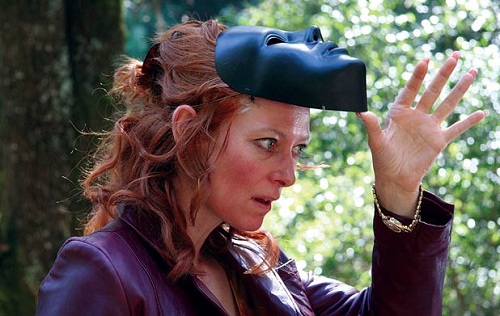After the surprising thematic unity of day two of Ebertfest (the four films screened explored similar topics), with day three’s picks Roger Ebert seemed more interested in exploring contradictions. The day began with director Joachim Trier’s Oslo, August 31st, a Norwegian film that follows a recovering drug addict, Anders, over the course of his day. Anders has two weeks left in his rehabilitation facility outside the city and is given a day’s leave so he can go to Oslo for a job interview. The film rides along peacefully with Anders over this day, allowing the audience to sit with him, trying to piece together a picture of this rather complicated man; who he is, who he was, and how he got where he is. It doesn’t seek to give answers, rather it embraces the reality that for many addicts, there isn’t one triggering factor or illuminating insight.
The central performance by Anders Danielsen Lie, a doctor by trade, is impressively nuanced and still and the film takes just the right amount of time to tell its rather straightforward story, providing substance while conveying the occasionally trudging, occasionally fleeting passage of time. Co-writer and director Joachim Trier was on hand after the film for a Q&A and the discussion proved thought provoking. Trier shared his personal connection with the film and his interest in exploring what brings someone with promise and support to the place where we find Anders. After seeing Oslo, August 31st, I look forward to catching up with Trier’s first film, Reprise, as well as what he does next.
After Oslo came The Ballad of Narayama, a 1958 film directed by Keisuke Kinoshita. Whereas Oslo is incredibly simple in its design and tone, Narayama plays with artifice from its opening moments. This massive production uses heightened performances and scripting, along with theatrical staging and set design, to place its characters into clearly defined roles. Kinuyo Tanaka is Orin, the saintly grandmother. Teiji Takahashi is Tatsuhei, the respectful son, and Danshi Ichikawa is Kesakichi, the disrespectful and indolent grandson. Based on Japanese folklore, as well as Men of Tohoku by Shichiro Fukazawa, Narayama tells the story of Orin, who decides she must, following tradition, be carried up Mt. Narayama by her son and be left to die after her 70th birthday, which approaches quickly.
The theatrical staging and performances, though distracting at first, become increasingly appropriate as the stakes of the film grow until the final set piece, the walk up the mountain, which though it is a deliberate, 20 minute sequence, leaves the audience breathless with its intensity. The film has a tremendous amount to say about Japanese society, both of the ‘50s and the culture that created the folklore in the first place, as well as death, aging, gender roles, and much, much more. It’s a beautiful film as well, having been shot in Technicolor, and it looked fantastic on the Virginia Theatre’s massive screen. Though no one involved in the production of the film was present for the Q&A (a reality of showing older films), film historian David Bordwell led a discussion of the history of the film, its ties to the original story, and the book from which it’s adapted, as well as the tradition of kabuki. It was an incredibly enlightening discussion, as Bordwell is such a knowledgeable and engaging presenter.
The final screening of the night was Erick Zonca’s Julia. Like Oslo, it centers on an addict, but rather than the still and contemplative Anders we get Tilda Swinton as Julia, a boisterous and scheming alcoholic. Unlike the women of Narayama, Julia is constantly failing herself and those around her and she lacks the grace to healthfully handle the stresses life throws at her. Narayama, we were told, was a late addition to the festival and actually the final film to be chosen. While its depictions of femininity and discussion of death make it a fascinating parallel to Julia and Oslo (and the self-annihilation that addicts so often seek), the clearer pair are the bookends of the day.
An unpredictable thriller, Julia centers on Swinton’s titular character as she finds herself in increasingly bizarre and dangerous situations. Whereas Anders spends the majority of his film desperately seeking connection and truth, Julia can’t stop lying; whereas Oslo peoples its world with the mundane, Julia meets increasingly colorful and heightened characters throughout the film, as the reality of the film seemingly adapts to meet the character’s imagination and ability to deceive. Swinton and Aidan Gould as the young Tom are excellent and they ground what could easily be a preposterous story with the believability and truth of their performances. After the film, Tilda Swinton came out to do a Q&A, discussing her approach to the character as well as her current MoMA installation, The Maybe, and the career trajectory that took her from a writing major to her current self-described job of Artist’s Model/Clown.
Day three was another thought-provoking one at Ebertfest and, while the highlight of the festival to this point remains In The Family (once again, seek this film out!), the interesting connections and discussions prompted by these excellent films, and their programming together, just makes me all the more curious and excited for whatever Roger, Chaz, and the whole Ebertfest crew have in store for us tomorrow.
Kate Kulzick
Check out the rest of my Ebertfest 2013 coverage:
Day 1- “I Remember” and Days of Heaven
Day 2- “To Music”, Vincent: The Life and Death of Vincent van Gogh, In the Family, Bernie
Day 4- Blancanieves, Kumaré, Escape From Tomorrow, The Spectacular Now
Day 5– “Sight and Sound Poll: Roger Ebert’s Favorite Films”, Not Yet Begun to Fight
And make sure to check out the video archive for the festival, featuring the introductions to all of the films, the Q&As afterwards, and the panel discussions.




